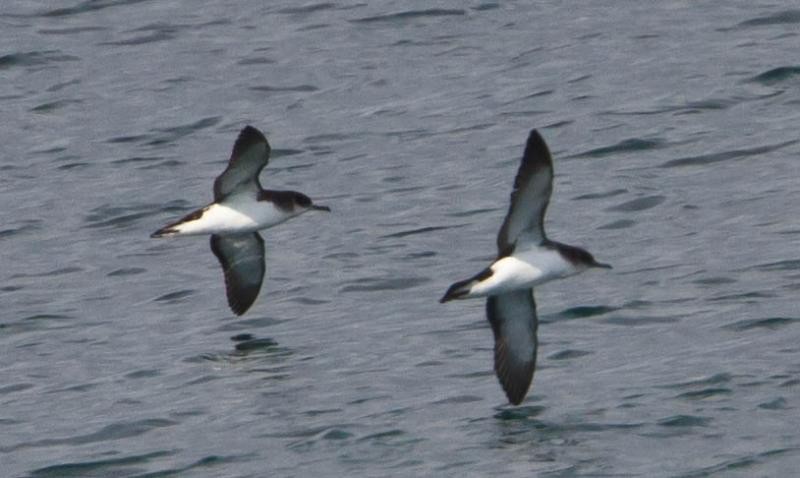Manx Shearwater
A species of Typical Shearwaters Scientific name : Puffinus puffinus Genus : Typical Shearwaters
Manx Shearwater, A species of Typical Shearwaters
Botanical name: Puffinus puffinus
Genus: Typical Shearwaters
Content
Description General Info
Description
The Manx shearwater is 30–38 cm (12–15 in) with a 76–89 cm (30–35 in) wingspan and weighs 350–575 g (12 ⁄2–20 ⁄2 oz). It has the typically "shearing" flight of the genus, dipping from side to side on stiff wings with few wingbeats, the wingtips almost touching the water. This bird looks like a flying cross, with its wings held at right angles to the body, and it changes from black to white as the black upper parts and white under sides are alternately exposed as it travels low over the sea. 
Size
34 cm (13.5 in)
Life Expectancy
50 years
Nest Placement
Burrow
Feeding Habits
Manx Shearwater dines on small fish, crustaceans, and cephalopods, often foraging alone or in small groups. Utilizing surface seizing and pursuit diving, manx Shearwater can locate prey over large distances by scent. Unique among its feeding traits is the rare association with boats or other shearwaters.
Habitat
Manx Shearwater's habitat mainly comprises marine environments, soaring over oceanic expanses and breeding in burrows on coastal or island terrains. These birds inhabit higher elevations, frequenting hilltops and mountain slopes up to 700 meters. They span the North Atlantic Ocean for breeding, especially on North Atlantic islands, and range to Northeastern North America. In non-breeding seasons, manx Shearwater migrates to the South Atlantic, wintering along South American and South African waters.
Nest Behavior
Manx Shearwater's start nesting at 5-6 years, potentially pairing for life. Nesting occurs only at night, with pairs courting in the burrow weeks before laying a single egg.
Nest Characteristics
Manx Shearwater nesting involves burrows, typically 3-6 feet long, often reused annually. The nest chamber is sparsely lined with grass and leaves.
Dite type
Piscivorous
General Info
Feeding Habits
Bird food type
Behavior
Manx shearwaters are long-lived birds. A Manx shearwater breeding on Copeland Island, Northern Ireland, was as of 2003/04, the oldest known living wild bird in the world: ringed as an adult (at least 5 years old) in July 1953, it was retrapped in July 2003, at least 55 years old. This is a gregarious species, which can be seen in large numbers from boats or headlands, especially on migration in autumn. It is silent at sea, but at night, the breeding colonies are alive with raucous cackling calls. 
Distribution Area
The Manx shearwater is entirely marine, typically flying within 10 m (30 ft) of the sea surface. It nests in burrows on small islands, which it visits only at night. Its nesting colonies are in the north Atlantic Ocean in the United Kingdom, Ireland, Iceland, the Faroe Islands, France, the Isle of Man, the Channel Islands, the Azores, Canary Islands, and Madeira. The most important colonies, with a total of more than 300,000 pairs, are on islands off Wales, Scotland, and Northern Ireland. Three-quarters of the British and Irish birds breed on just three islands; Skomer, Skokholm, and Rùm. Around 7000–9000 pairs breed in Iceland, with at least 15,000 pairs on the Faeroes. Other populations are of at most a few hundred pairs. The northeast of North America has recently been colonised from Newfoundland and Labrador to Massachusetts; although breeding was first recorded in 1973, populations remain small. Records in the northeast Pacific are increasing, and breeding has been suspected in British Columbia and Alaska. During the breeding season birds regularly commute between their colony and offshore feeding grounds that can be up to 1,500 km away. For example, adult Manx shearwaters rearing their chick on the west coast of Ireland have been observed to travel all the way to the Mid-Atlantic Ridge to feed when the conditions are right. The breeding colonies are deserted from July to March, when the birds migrate to the South Atlantic, wintering mainly off Brazil and Argentina, with smaller numbers off southwest South Africa. The journey south can be over 10,000 km (6,000 mi), so a 50-year-old bird has probably covered over a million km (600,000 mi) on migration alone. The migration also appears to be quite complex, containing many stopovers and foraging zones throughout the Atlantic Ocean. Ornithologist Chris Mead estimated that a bird ringed in 1957 when aged about 5 years and still breeding on Bardsey Island off Wales in April 2002 had flown over 8 million km (5 million mi) in total during its 50-year life. Manx shearwaters are able to fly directly back to their burrows when released hundreds of kilometres away, even inland. 
Species Status
Not globally threatened.
Scientific Classification
Phylum
Chordates Class
Birds Order
Albatrosses and Petrels Family
Shearwaters and petrels Genus
Typical Shearwaters Species
Manx Shearwater 